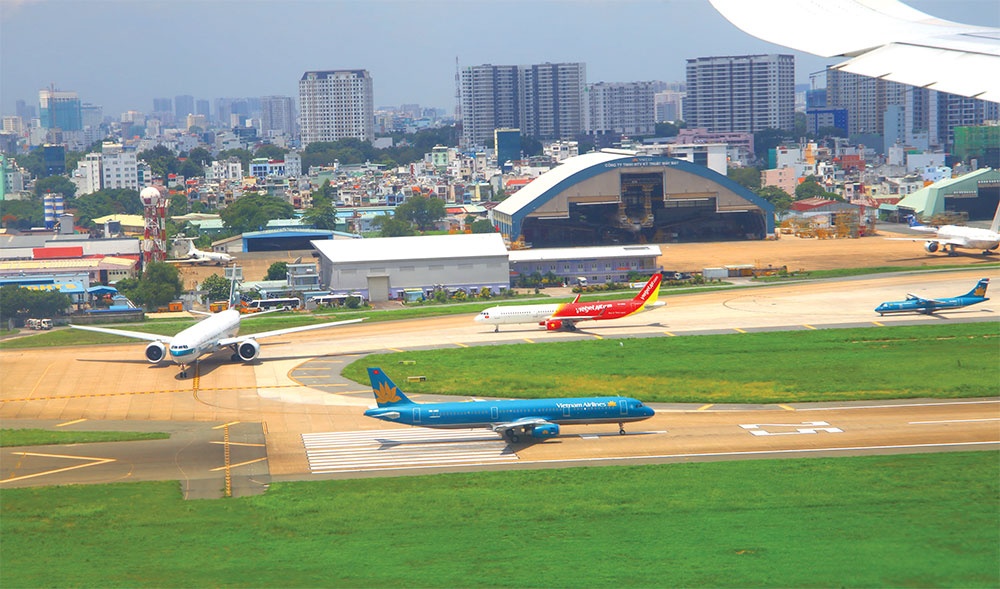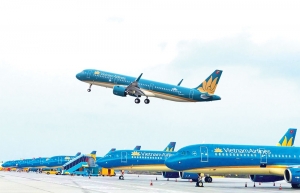Contrasting complexions representing aviation arena
The new report handed from the Civil Aviation Authority of Vietnam (CAAV) to the Ministry of Transport (MoT) outlines that the domestic aviation sector has recovered in recent times.
 |
| Contrasting complexions representing aviation arena |
In December, the passenger transport volume of Vietnamese airlines reached 3.5 million passengers, an increase of over 1,850 per cent compared to November 2021; domestic passenger volume reached 2.9 million, an uptick of nearly 1,700 per cent; and international arrivals reached 614,000, an increment of 3,575 per cent compared to October 2021.
The volume of passenger and freight transportation by Vietnamese airlines has increased by more than three digits compared to the same time in 2021 for the seventh consecutive month. In August, the domestic aviation market nearly returned to pre-pandemic levels.
The authority forecasts that for 2022, airlines have served 43.2 million domestic passengers (a 3.5-fold increase over 2021 and a 15.6 per cent rise over 2019) and 152,000 tonnes of cargo (equal to 2021 and equal to 60 per cent of 2019).
CAAV director Dinh Viet Thang stated, “The people’s demand for travel and tourism has been released after a prolonged period of pent-up demand, which has aided the domestic aviation market to recover faster than anticipated, particularly on the North-South axis routes and routes connecting Hanoi and Ho Chi Minh City to major tourist destinations.”
People’s rising desire for travel has enabled Vietnamese airlines to expand their operations, add new routes, and boost frequency in order to suit customers’ travel demands.
At the end of December 2022, five airlines had operated a total of 69 domestic routes, an increase of five compared to the same time in 2019. Vietnam Airlines and Vietjet have the greatest network of routes in Vietnam.
Behind anticipation
The domestic aviation market is recovering so rapidly that the International Air Transport Association has ranked Vietnam as one of the 25 fastest-recovering domestic markets in the world, with the Hanoi-Ho Chi Minh City route returning to the list of the four busiest routes worldwide last summer.
Nevertheless, the quicker the local transport industry recovers, the more it underlines the standstill of international air transport, which generated the majority of revenues for Vietnamese airlines before the outbreak.
Although Vietnam lifted restrictions on entry passengers in March and reinstated a visa-free policy for 25 nations two months later, the recovery rate in the segment has not occurred as anticipated.
International transportation is anticipated to have reached 11 million people in 2022 (a 22-fold increase compared to 2021) and 1.1 million tonnes of cargo. Less than half of these are foreign passenger flights by Vietnamese carriers.
Chris Farwell, a representative of the Tourism Advisory Board, said that Vietnam was one of the first nations in the area to reopen. Nevertheless, Vietnam has not been able to capitalise on its leadership position since it only welcomed around 3.5 million foreign visitors in 2022. This is far less than the anticipated target of five million foreign tourists, generating $4.5 billion in total revenue.
“No location in Vietnam has regained half of its foreign tourist visits since the start of 2020. Not only did the lack of international tourists cause issues for travel agencies and tour operators, but it also caused Vietnamese airlines to lose an enormous amount of income despite their aggressive efforts to rescue themselves,” Farwell said.
Vietjet was the first to open the door to the Indian market to compensate for losses in traditional markets such as China and Northeast Asia, said Vietjet CEO Dinh Viet Phuong. “This market has a very high demand, but the visa issue prevents the number of tourists from meeting projections. We recommend that this problem be remedied as soon as possible so that the aviation and tourist sectors may quickly recover.”
Beginning on December 9, Chinese officials have permitted the restoration of a limited number of regular routes into the country, at 15 flights per week. Passenger quarantine standards remain stringent; hence, the effect of reopening a market that formerly ranked first in terms of revenue and profits for many Vietnamese airlines remains insufficient.
A Vietnam Airlines executive said that it continues to carefully watch developments in China’s pandemic control programme in order to restore flying frequencies as soon as possible.
Maintaining flow of cash
The slow international market has resulted in a significant supply surplus for most domestic airlines, particularly the two market giants of Vietnam Airlines and Vietjet. At the two major international airports, Tan Son Nhat and Noi Bai, there are a considerable number of aircraft belonging to these two groups.
Due to an excess of supply, airlines are engaged in vigorous price competition. Therefore, despite the swift recovery and expansion of the domestic market, it did nothing to improve the airlines’ already dire financial condition.
In 2022, as the airline with the largest market share in passenger and cargo transportation, Vietnam Airlines had to aggressively and supplement profit and equity through solutions to recover and improve business results, minimising losses, and restructuring assets and investment portfolios to increase income and cash flow. These are also solutions for the company’s 2021-2025 reorganisation strategy, which has been presented to the appropriate authorities for approval by the corporation.
While awaiting the approval of the scheme, Vietnam Airlines has implemented a number of restructuring solutions within its control, such as negotiating the extension of overdue payments, liquidating assets (during the first six months of 2022, two old aircraft were successfully sold), accelerating the progress of asset restructuring (selling and leasing of aircraft), and reducing unnecessary costs.
However, the aforementioned options can only assist the national airline in reducing losses. They are incapable of balancing revenues and expenditures for fiscal year 2022. One aviation expert said, “The greatest problem for Vietnamese airlines in 2023 will be maintaining cash flow until the market completely recovers at the end of the year.”
Vietnam’s aviation sector continues to confront several problems and hurdles, including swings in global petroleum prices and currency rate fluctuations.
Jet fuel prices, which have been twice the average price of 2019, result in a significant loss of cash flow, financial balance, and profit for Vietnamese airlines. In addition, negative events in the real estate market, financial markets, and credit markets have a significant impact on the working capital of businesses.
Phuong of Vietjet predicted that 2023 will continue to be a challenging year for the aviation sector, as petrol prices are likely to stay at about $105 per barrel. In addition, the consequences of the opening-up strategy of the Chinese economy are still uncertain, the US Federal Reserve continues to maintain a policy of high interest rates, and the globe continues to be rife with volatility and unanticipated hazards.
“In this regard, Vietnamese airlines will continue to need assistance and support from the government, particularly the continuous lowering of some fees and levies and access to new loans with advantageous interest rates,” Phuong said.
Currently, a number of domestic airlines are asking the MoT to continue using the policy of cutting domestic take-off and landing costs and flight management fees by 50 per cent in 2023, as was the case in 2020 and 2021.
“The state still cannot allow airlines to operate independently if it wants to maintain the competitiveness of domestic airlines in comparison to foreign carriers when the international market returns to its pre-pandemic level in 12-18 months,” said one expert.
| The Civil Aviation Authority of Vietnam predicts that the whole air transport market will reach 80 million passengers and 1.44 million tonnes of cargo in 2023, an increase of 45.4 per cent for passengers and 15 per cent for cargo, respectively, over 2022. Compared to the same period before the pandemic, there will be an increase of approximately 1 per cent in passengers and 14.2 per cent in cargo, with domestic transport reaching 45.5 million passengers, an increase of 5 per cent compared to 2022; and 230,000 tonnes of cargo increasing by 51 per cent compared to 2022. International transportation could carry 34.3 million passengers, which is 3.1 times more than in 2022, and 1.21 million tonnes of cargo, which is an increase of 10 per cent from 2022. As of mid-November 2022, there were 251 aircraft registered with Vietnamese nationality. Vietnam Airlines operate 102 aircraft, Vietjet 77 aircraft, Bamboo Airways 30, Pacific Airlines 13, Viettravel Airlines with three, Hai Au Aviation with seven aircraft, Blue Planet Aviation with five, and Sun Air with three aircraft. |
 | Reforming the aviation sector The proximity of connecting airports is not a decisive determinant of the performance of an operation, and private-public partnership (PPP) in the reshaping of national aviation infrastructure should be encouraging, a workshop has heard. |
 | Aviation pressured to turn into regional freight centre Vietnam has the potential to become a new logistics centre for the continent alongside Singapore, Bangkok, and Kuala Lumpur, if sectors such as aviation are utilised suitably. |
What the stars mean:
★ Poor ★ ★ Promising ★★★ Good ★★★★ Very good ★★★★★ Exceptional
Related Contents
Latest News
More News
- Vietnam's top 500 value-creating enterprises announced (December 27, 2025 | 08:00)
- The PAN Group shaping a better future with ESG strategy (December 26, 2025 | 09:00)
- Masan Consumer officially lists on HSX, marking the next phase of value creation (December 25, 2025 | 13:20)
- MCH to become the largest consumer stock on VN-Index (December 24, 2025 | 11:05)
- Oil and gas firms post strong 2025 results (December 22, 2025 | 17:42)
- SABECO wins multiple international beer awards (December 22, 2025 | 17:41)
- UOB sees Vietnam growth easing in fourth quarter (December 22, 2025 | 17:39)
- First members of Danang International Finance Centre revealed (December 22, 2025 | 17:39)
- Human-centred governance seen as key to AI development (December 19, 2025 | 18:19)
- Top 10 notable events of Vietnam’s industry and trade sector in 2025 (December 19, 2025 | 14:00)

 Tag:
Tag:






















 Mobile Version
Mobile Version